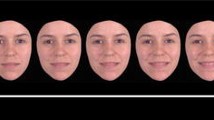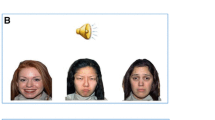Abstract
The impact of facial emotion recognition (FER) deficits on facial emotion expression (FEE) during interaction with a novel computerized system was investigated in children with ASD (n = 20), in comparison to typically developing (TD) peers (n = 20). Although there was not clear evidence of impaired FEE, children with ASD showed more atypical FEE. In children with ASD, better FER predicted better FEE when the participants were asked to express a labeled emotion (t(18) = − 2.75, p = .01, d = 1.24). The stronger relationship between FER and FEE in children with ASD, relative to controls, suggests that intervention targeting social communication deficits might have maximal effect when both processes are considered.



Similar content being viewed by others
References
Aly, S., Abbott, A. L., Wieckowski, A. T., White, S. W., & Youssef, A. E. (2018). Fast 3D facial expression recognition. Manuscript submitted for publication.
American Psychiatric Association. (2013). Diagnostic and statistical manual of mental disorders (5th ed.). Washington, DC: APA.
Aspan, N., Vida, P., Gadoros, J., & Halasz, J. (2013). Conduct symptoms and emotion recognition in adolescent boys with externalization problems. The Scientific World Journal. https://doi.org/10.1155/2013/826108.
Brosnan, M., Johnson, H., Grawmeyer, B., Chapman, E., & Benton, L. (2015). Emotion recognition in animated compared to human stimuli in adolescents with autism spectrum disorder. Journal of Autism and Developmental Disorders, 45(6), 1785–1796.
Capps, L., Yirmiya, N., & Sigman, M. (1992). Understanding of simple and complex emotions in non-retarded children with autism. Journal of Child Psychology and Psychiatry, 33(7), 1169–1182.
Evers, K., Steyaert, J., Noens, I., & Wagemans, J. (2015). Reduced recognition of dynamic facial emotional expression and emotion-specific response bias in children with an autism spectrum disorder. Journal of Autism and Developmental Disorders, 45(6), 1774–1784.
Faso, D. J., Sasson, N. J., & Pinkham, A. E. (2015). Evaluating posed and evoked facial expressions of emotion from adults with autism spectrum disorder. Journal of Autism and Developmental Disorders, 45(1), 75–89.
Grossman, J. B., Klin, A., Carter, A. S., & Volkmar, F. R. (2000). Verbal bias in recognition of facial emotions in children with Asperger syndrome. Journal of Child Psychology and Psychiatry, 41(3), 369–379.
Grossman, R. B., Edelson, L. R., & Tager-Flusberg, H. (2013). Emotional facial and vocal expressions during story retelling by children and adolescents with high-functioning autism. Journal of Speech, Language, and Hearing Research, 56(3), 1035–1044.
Harms, M. B., Martin, A., & Wallace, G. L. (2010). Facial emotion recognition in Autism spectrum disorders: A review of behavioral and neuroimaging studies. Neuropsychology Review, 20(3), 290–322.
Humphreys, K., Minshew, N., Leonard, G. L., & Behrmann, M. (2007). A fine-grained analysis of facial expression processing in high-functioning adults with autism. Neuropsychologia, 45(4), 685–695.
Jenness, J. L., Hankin, B. L., Young, J. F., & Gibb, B. E. (2014). Misclassification and identification of emotional facial expressions in depressed youth: A preliminary study. Journal of Clinical Child and Adolescent Psychology, 44(4), 559–565. https://doi.org/10.1080/15374416.2014.891226.
Kasari, C., Sigman, M., Mundy, P., & Yirmiya, N. (1990). Affective sharing in the context of joint attention interactions of normal, autistic, and mentally retarded children. Journal of Autism and Developmental Disorders, 20(1), 87–100.
Keltner, D., Moffitt, T. E., & Stouthamer-Loeber, M. (1995). Facial expressions of emotion and psychopathology in adolescent boys. Journal of Abnormal Psychology, 104(4), 644–652.
Korkman, M., Kirk, U., & Kemp, S. (2007). NEPSY-II: A developmental neuropsychological assessment. San Antonio: The Psychological Corporation.
Langdell, T. (1981). Face Perception: An approach to the study of autism. Doctoral Thesis, University of London.
Lord, C., Rutter, M., DiLavore, P. C., Risi, S., Gotham, K., & Bishop, S. L. (2012). Autism diagnostic observation schedule (ADOS-2) (2nd ed.). Torrence: Western Psychological Services.
Loveland, K. A., Tunali-Kotoski, B., Pearson, D. A., Brelsford, K. A., Ortegon, J., & Chen, R. (1994). Imitation and expression of facial affect in autism. Development and Psychopathology, 6(3), 433–444.
Lozier, L. M., Vanmeter, J. W., & Marsh, A. A. (2014). Impairments in facial affect recognition associated with autism spectrum disorders: A meta-analysis. Development and Psychopathology, 26(4), 933–945. https://doi.org/10.1017/S0954579414000479.
Matsumoto, D., & Willingham, B. (2009). Spontaneous facial expressions of emotion of congenitally and noncongenitally blind individuals. Journal of Personality and Social Psychology, 96(1), 1.
Nuske, H. J., Vivanti, G., & Dissanayake, C. (2013). Are emotions impairments unique to, universal, or specific in autism spectrum disorder? A comprehensive review. Cognition & Emotion, 27(6), 1042–1061.
Rhind, C., Mandy, W., Treasure, J., & Tchanturia, K. (2014). An exploratory study of evoked facial affect in adolescent females with anorexia nervosa. Psychiatry Research, 220(1–2), 711–715. https://doi.org/10.1016/j.psychres.2014.07.057.
Ricciardi, L., Visco-Comandini, F., Erro, R., Morgante, F., Bologna, M., Fasano, A., et al. (2017). Facial emotion recognition and expression in Parkinson’s disease: An emotional mirror mechanism?. PLoS ONE, 12(1), e0169110.
Rump, K. M., Giovannelli, J. L., Minshew, N. J., & Strauss, M. S. (2009). The development of emotion recognition in individuals with autism. Child Development, 80(5), 1434–1447.
Rutherford, M. D., & McIntosh, D. N. (2007). Rules versus prototype matching: Strategies of perception of emotional facial expressions in the autism spectrum. Journal of Autism and Developmental Disorders, 37(2), 187–196.
Sasson, N. J., Faso, D. J., Nugent, J., Lovell, S., Kennedy, D. P., & Grossman, R. B. (2017). Neurotypical peers are less willing to interact with those with autism based on thin slice judgments. Scientific Reports, 7, 40700.
Shalom, D. B., Mostofsky, S. H., Hazlett, R. L., Goldberg, M. C., Landa, R. J., Faran, Y., et al. (2006). Normal physiological emotions but differences in expression of conscious feelings in children with high-functioning autism. Journal of Autism and Developmental Disorders, 36(3), 395–400.
Stagg, S. D., Slavny, R., Hand, C., Cardoso, A., & Smith, P. (2014). Does facial expressivity count? How typically developing children respond initially to children with autism. Autism, 18(6), 704–711.
Tabachnick, B. G., & Fidell, L. S. (2012). Using multivariate statistics (6th ed.). Boston: Pearson.
Wechsler, D. (2011). Wechsler Abbreviated Scale of Intelligence-Second Edition (WASI-II). San Antonio: NCS Pearson.
Yirmiya, N., Kasari, C., Sigman, M., & Mundy, P. (1989). Facial expressions of affect in autistic, mentally retarded and normal children. Journal of Child Psychology and Psychiatry, 30(5), 725–735.
Zonnevijlle-Bender, M. J. S., van Goozen, S. H. M., Cohen-Kettenis, P. T., van Elburg, A., & van Engeland, H. (2002). Do adolescent anorexia nervosa patients have deficits in emotional functioning? European Child & Adolescent Psychiatry, 11(1), 38–42. https://doi.org/10.1007/s00787-004-0351-9.
Acknowledgments
This project was funded by a Grant from NICHD (R03HD081070; Co-PIs Abbott & White).
Author information
Authors and Affiliations
Contributions
ATW participated in the Collected data, performed data analysis and drafted the manuscript. DMS participated in the Collected data, performed data analysis and contributed to writing of the manuscript. ALA Contributed to planning and design of the study and revision of the manuscript. SWW Conceived the study, designed the study, contributed to writing of the draft and revision of the manuscript.
Corresponding author
Additional information
This study was conducted at Virginia Tech.
Rights and permissions
About this article
Cite this article
Wieckowski, A.T., Swain, D.M., Abbott, A.L. et al. Task Dependency When Evaluating Association Between Facial Emotion Recognition and Facial Emotion Expression in Children with ASD. J Autism Dev Disord 49, 460–467 (2019). https://doi.org/10.1007/s10803-018-3712-9
Published:
Issue Date:
DOI: https://doi.org/10.1007/s10803-018-3712-9




